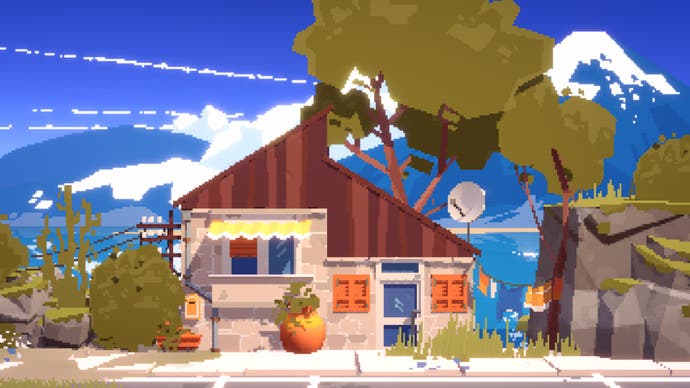Summerhouse review - a house-building toy that contains genuine magic
Finial fantasy.
There is an island in the Aegean, an island of stray cats and tumbling bougainvilleas, that has an instagram account devoted exclusively to its many doors. This account is a catalogue of variations on a theme, the theme being how you get in and out of a building, the variation being - well... Where to start? Modern doors, ancient doors. Doors of wood and doors of iron. Doors that are perfectly kept up, doors that are leaning, addled, barely hanging in there. Doors set with glass and doors set with grillwork. The doors are great individually, but it's together that they truly shine. You glimpse something of us as a species, I think, in their endless twists and reconfiguring, their fitness and anti-fitness for purpose.
If you are the kind of person who likes the idea of exploring the endless variation found within doors, Summerhouse is for you. And it's not just doors. Oh, the doors are great. They're nifty! Metal doors with an industrial feel, but also wooden double doors, perfect for an old junk shop. Sliding convenience-store doors. A round Hobbit number - painted green, of course.
But there are windows, rooves, finials and oddments like signage, rattling drainpipes, posters and hoardings. Fancy a polite little noticeboard? Fancy a lone payphone set, lollipop-style, upon a stick? Fancy trees and shrubs, wild and in pots? Walls of stone, walls of wood. Keep scrolling; even before the unlocks bring you a ghost amongst long grass and a cat lounging on an air-con unit, it's all here.
Summerhouse is a toy. A building toy, and more accurately a doodling toy. You select a backdrop, ranging from a scrubby, overgrown river to a Road-Runner desert, and then you head for the menus and select house parts, dragging, dropping and inverting. You can spam pieces and you can push pieces further into the background or draw them forward. You can work precisely, creating mansions of perfect symmetry, or you can be slapdash and whack things together in seconds. Many hours in, I am currently a student of leaving things out: a door, a few windows, an air-con unit, but no walls, all of this stuff just floating in silent space. Architecture by way of Magritte.
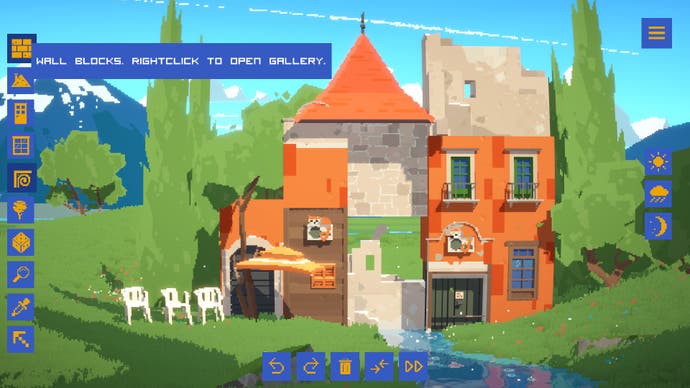
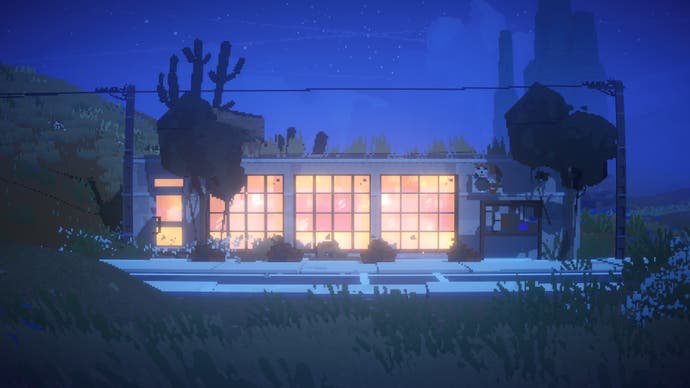
I've been playing this for a while, always idly, always without a plan, always happy to see where the game takes me. And it's taken me a while to learn two things about it. The first is that this is a uniquely peaceful game. I would say it's meditative, but I can be more direct: what it's really good for, and what I value more than anything, is that it can completely empty my head. It does this in part because it all just works. Placing, selecting, deleting: none of this is tricky. You can pull out a bit and you can pan from side to side, and within seconds you can build a new house to go along with the first one you've made. You don't need to think, you can just do, and you'll end up with something pleasing. It casts a cooling spell, Summerhouse, and I am grateful for it.

And I think the reason it does all this is because of the second thing. It took an age for me to spot this, but you're not really making new houses here. You're making old houses, sometimes dilapidated houses, houses that have been lived in and patched together. An example, and one that is close to my heart, is that Summerhouse is absolutely golden when it comes to making strip-malls, the sad single-storey stucco wonderlands beloved of Southern California. Take the off-white wall, set it halfway into the earth, whack on the convenience store door and then a few of those gorgeous medium-format windows with the ironwork and you're done. You're ready to open a hairdressers, a lockbox unit, a surprisingly brilliant deli. What Summerhouse excels at, then, and I might be overreaching here, is not architecture so much as vernacular - buildings that have come into the world untroubled by architects. The kind of buildings that make up the world but, because of their ubiquity and modesty, can be difficult to truly see.
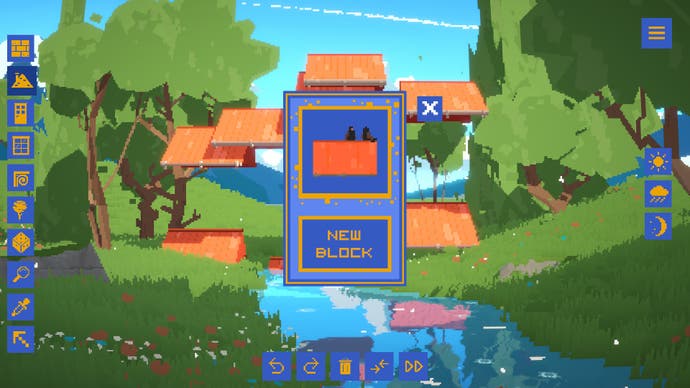
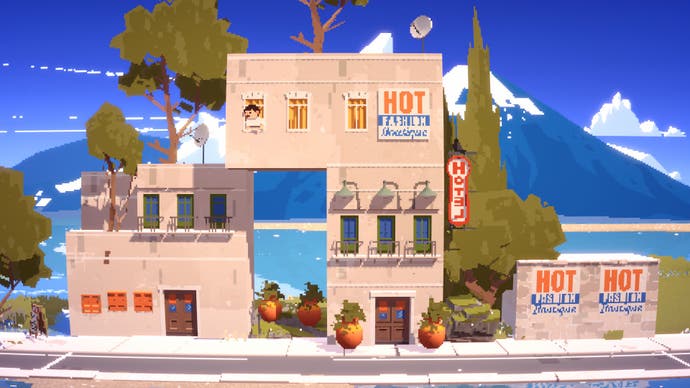
But when you see them, when you learn to focus on these ageing, discolouring, sun-lasered things, you are rewarded. A favourite photographer at Eurogamer, and another Instagram gem, is casualtimetravel. Sinziana Velicescu takes pictures of industrial buildings, apartment blocks, Dingbats, and takes their cool surfaces and blunt edges and creates unintentional abstraction, ancient modernism, buildings that bring all kinds of interesting words and thoughts to mind, purely by doing something with simplicity, a weather eye on utility, and a certain hard-to-locate charisma.
Yes, all that. But you can also make teetering chateaus, or old Italian buildings with clotheslines strung between windows, with trees on the roof and grass in the gutter. Each construction ends up feeling highly specific, and one of my favourite little things to do in Summerhouse is create a building and then change the time, from day to night, and watch the white walls turn light blue, while the lights come on in all those windows - a thin, tea-stained light that reveals the muddled form of something unique behind each frame while insects gather outside.
So many games emerge. My daughter is raised on Youtube and things like the three marker challenge, where you have to draw something with just three pens. She loves Summerhouse and loves to impose similar restrictions: Make a pagoda, but it's just roofing. Let's both see what we can make in a minute only using guttering. And when it's all done, Summerhouse has one final trick: the replay button, which brings your creations back into focus by working through their constructions one piece, one pop, one click at a time. It's magic. The whole thing is magic.
